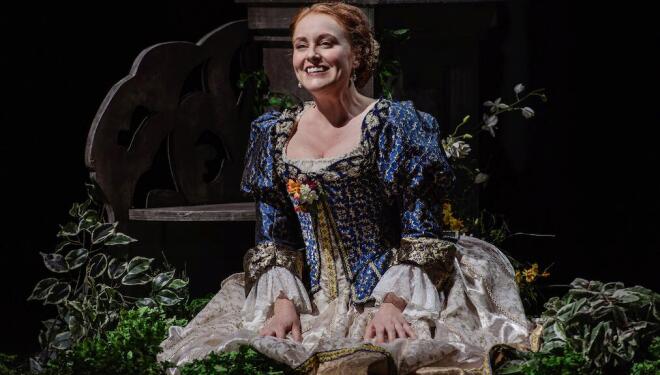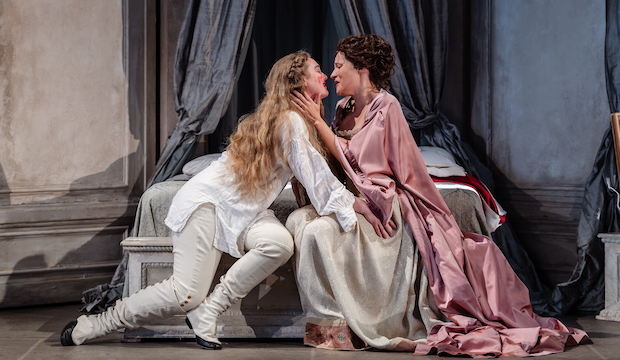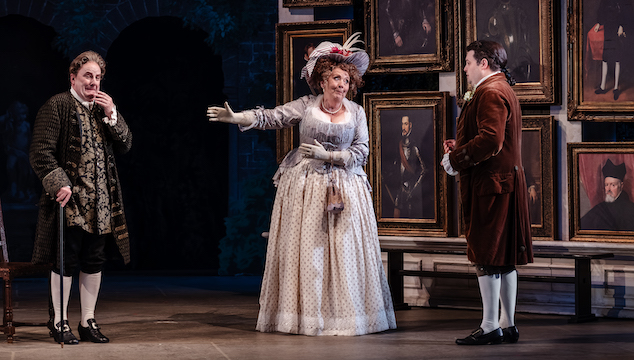
Figaro embraces the events of one single day in the palace of the Count and Countess Almaviva, Spanish nobles living outside Seville. As servants Figaro and Susanna decorate their new quarters, Susanna (Claire Lees, a fine soprano with great dramatic presence) has to spell out the Count's lecherous intentions – the women of Figaro are far shrewder than the men.
Austrian baritone Rafael Fingerlos’ sauntering Count is a suitably louche with his long hair and open dressing gown. While he and David Ireland's Figaro enter into a macho battle of wits, well matched in voice, the Countess (sung by the impressive soprano Samantha Clarke) and Susanna team up, setting in motion a sequence of events that leads to the mad denouement of mistaken identity in the palace garden late at night. 
Cherubino (Bethany Horak-Hallett) and the Countess (Samantha Clarke). Photo: Julian Guidera
The many comic confusions of the opera are executed in great style, from the discovery of page Cherubino (mezzo-soprano Bethany Horak-Hallett) in Susanna’s room to his leap from a high window into the flower-bed below, running out of the side-door of the opera house and through the glorious herbaceous borders, to the wrath of the gardener.
Of course the opera is more than a succession of jolly gags, thanks to Mozart’s music. There are moments of true sadness that underline the characters’ very human qualities. In the brief aria where Barbarina (Stephanie Hershaw) bewails the loss of a critical pin, she communicates her predicament intensely, in a beautifully clear voice. Similarly, in her aria 'Dove sono', the Countess expresses her unhappiness about the Count’s coldness with great poignancy.
Clarke, definitely a name to watch out for, beautifully captures the majesty of a dignified, desolate figure, taking us with her as she moves from despair to resolution. Her presence on stage is aided by magnificent outfits (design by Robert Perdziola), from a sweeping pink dressing gown in Act 2, to a shimmering deep red shot silk dress in Act 3, to a sumptuous red and gold evening dress in her dramatic appearance in the midnight garden scene at the end of the opera.
Robert Perziola's ancestral set and lavish costumes. Photo: Julian Guidera
There is strong support for the singers from the Philharmonia Orchestra under the baton of the award-winning Norwegian conductor Tabita Berglund, who, right from the flowing strings of the opening bars of the overture, produced a superb sound from her players.
A final bravo for the stage design: after the opening scene in Figaro’s cramped quarters at the front of the stage in Act 1, as the opera progresses, successive layers of Perdziola’s sets are peeled away to reveal the garden of Count Almaviva in the Act 4. This is a production that gets both the detail and the big picture right.
Le Nozze di Figaro is sung in Italian with English surtitles. Further performances are on 7, 9, 15, 28 June, 6, 11, 14, 18, 21, 23 July. A shuttle coach meets trains from Marylebone: click here for details
| What | Le Nozze di Figaro, Garsington Opera review |
| Where | Garsington Opera, Wormsley Estate , Stokenchurch, HP14 3YG | MAP |
| Nearest tube | Marylebone (underground) |
| When |
01 Jun 24 – 23 Jun 24, 11 performances, with long dinner interval |
| Price | £220-£255 including voluntary donation |
| Website | Click here for details and booking |
